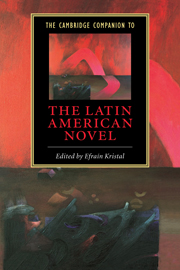10 - The lesbian and gay novel in Latin America
from Part III - Gender and sexuality
Published online by Cambridge University Press: 28 May 2006
Summary
Literary tradition can be defined in terms of a select corpus of texts that have held meaning for readers and critics. In the case of a homoerotic tradition, it is worth reflecting on whether what is at stake is the mention of gay, lesbian, bisexual, or transgender practices in literature, whether the sexuality of the authors is central, whether the works are judged “authentic” (which for many signifies the presence of positive images), whether they express an esthetics that is in some sense “queer,” whether they have some political content that ties them to programs of sexual liberation, and whether they are worth thinking about as works of literature. These questions are not even parallel to one another in terms of the semantic fields or epistemologies they invoke, so the difficulties of defining a tradition are obvious. Taking them one by one, then:
Is it sufficient for there to be gay and lesbian “themes” in a novel to claim it for such a tradition? Works as diverse as Mario Vargas Llosa’s Los cachorros (The Cubs, 1967), Conversación en la Catedral (Conversation in the Cathedral, 1969), and Historia de Mayta (The Real Life of Alejandro Mayta, 1984), Julio Cortázar’s Los premios (The Winners, 1960) and Leonardo Padura’s Máscaras (“Masks,”1996) have gay male characters, and Alúisio Azevedo’s O cortiço (A Brazilian Tenement, 1890), Juan Carlos Onetti’s Dejemos hablar al viento (Let the Wind Speak, 1979), and Rosario Castellanos’s Album de familia (“Family album,” 1971) have lesbian characters, but it is our contention that this is not sufficient to define these works as part of a Latin American homoerotic tradition, at least in the terms that we will be setting out here.
- Type
- Chapter
- Information
- The Cambridge Companion to the Latin American Novel , pp. 200 - 216Publisher: Cambridge University PressPrint publication year: 2005
- 3
- Cited by



